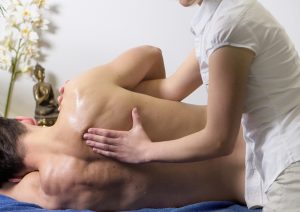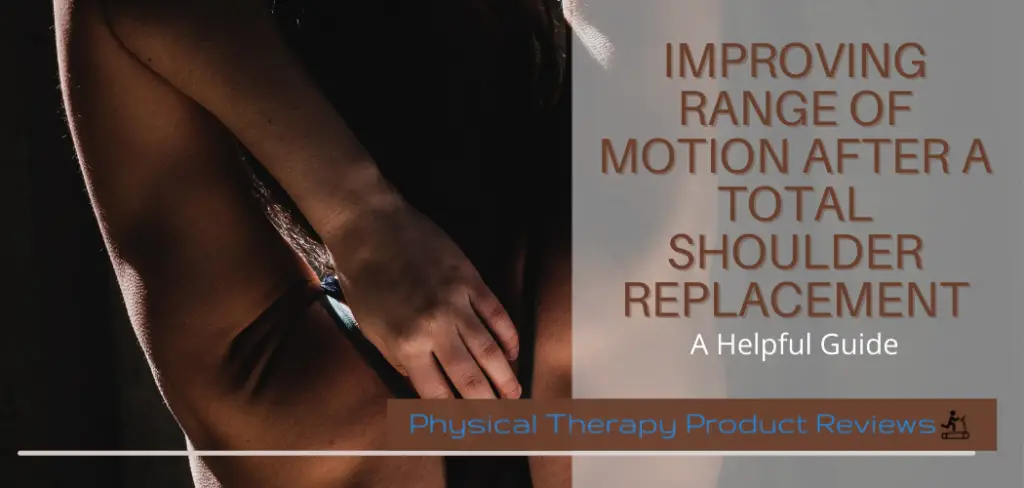 A Total Shoulder Replacement, also known as arthroplasty, is performed when traditional rehab has been unsuccessful at managing pain or maintaining function of the shoulder.
A Total Shoulder Replacement, also known as arthroplasty, is performed when traditional rehab has been unsuccessful at managing pain or maintaining function of the shoulder.
This procedure is often used to correct joint damage created by osteoarthritis, rotator cuff diseases, or even a shoulder fracture. The overall goal of shoulder arthroplasty is to restore function and improve motion and strength in the joint. For a successful outcome following surgery, you need to take the right steps early in your rehab.
After your surgery, you should expect to start Physical Therapy within one to two days. You’ll start with range of motion exercises. While you work to improve this, it’s important you try not to move your arm suddenly or with any force within the first 2-6 weeks after surgery.
While your initial exercises may seem simple, frequent gentle exercises have been proven to be more effective than irregular forceful exercises in gaining motion. During your rehab, a smooth progression of your range of motion without extreme soreness is paramount. With each stage of your recovery, be sure you can perform each exercise comfortably before progressing to the next level.
Stage 1: Day 1 - Week 4
The postoperative range of exercise will be performed immediately post-surgery. During this stage, a passive range of motion will be performed. The goal is to passively work towards 90° of forward flexion, 45° of external rotation, and 70° of internal rotation.
Some exercises that can be performed during this stage are:
Pendulums
- Lean over with your good arm supported on a table or chair.
- Relax the surgical arm, letting it hang straight down.
- Slowly begin to swing the relaxed arm in a small circle, gradually making it bigger if you can.
- Then reverse the direction.
- Next, move it backward and forward.
- Finally, move it side to side.
Passive Forward Flexion in Supine
- Lie on your back. Hold the surgical arm at the wrist with the opposite hand.
- Using the strength of the opposite arm, lift the affected arm upward, as if to bring the arm overhead.
- Slowly lower the arm back to the bed.
Passive ER
- Lie on your back, keeping the elbow of the surgical arm against your side with the elbow bent at 90 degrees.
- Using a cane or long stick in the opposite hand, push against the hand of the affected arm so that the affected arm rotates outward.
Stage 2: Weeks 4-6
 During this stage of recovery, you are working towards active motion as well as isometric use of the muscles of the shoulder. By the end of this stage of rehab, you should achieve:
During this stage of recovery, you are working towards active motion as well as isometric use of the muscles of the shoulder. By the end of this stage of rehab, you should achieve:
- Passive forward flexion of 140°
- 60+° of passive external rotation
- At least 70° of passive internal rotation.
- You should also be able to tolerate active motion to the shoulder, being able to perform forward flexion of 100° against gravity before progressing to the next stage.
Exercises that can be performed during this stage are:
AAROM FF/IR/ER with cane
- Using a cane or long stick for assistance, go through the forward flexion, internal rotation, and external rotation motions.
- Use the cane to assist your arm through the motion.
AROM FF/IR/ER
- Actively take your surgical arm through forward flexion, internal rotation, and external rotation motions.
- Attempt to maintain good mechanics and posture throughout.
Isometrics
Work on gentle isometric motions of forward flexion, internal, and external rotation.
Stage 3: Weeks 6-12
During this stage, you will continue to progress your active range of motion and activity as appropriate. During this stage, you can start to:
- Initiate assisted, behind-the-back internal rotation stretch and resisted internal and external rotation.

By the end of this stage, you should achieve:
- At least 140° forward flexion
- 60+° in ER
- 70° IR
- 120° active forward flexion against gravity.
Some exercises you perform during this stage:
Assisted IR behind the backstretch
- Sitting in a chair or standing, place the hand of the operated arm behind your back at the waistline.
- Use your opposite hand to help the other hand higher toward the shoulder blade
Resisted IR/ER
- Stand up straight with a resistance band held in your surgical arm, with the elbow bent to 90°.
- Keeping your elbow at your side, rotate your forearm into your body for internal rotation.
- Hold this position before gently letting the band recoil as you rotate your forearm away from you.
- Then perform rotating your forearm away from your body for external rotation.
How to Get Full ROM after Shoulder Replacement Surgery
Conclusion
From this point forward you will continue to progress your active range of motion and enhance the functional use of the arm. Throughout your rehab process you may experience increased pain and discomfort after your exercises, which is to be expected. During this time it is important to keep your pain under control with the use of ice and NSAIDS as needed after your exercises.
Works Cited
Liu JN, Steinhaus ME, Garcia GH, et al. Return to sport after shoulder arthroplasty: a systematic review and meta-analysis. Knee Surg Sports Traumatol Arthrosc. 2018;26(1):100–112.
Wagner ER, Solberg MJ, Higgins LD. The utilization of formal physical therapy after shoulder arthroplasty. J Orthop Sports Phys Ther. 2018;48(11):856–863.
Other Rehab Related Posts to Check Out
How to Stay Active After Cervical Fractures: Expert Tips and Advice
Dealing with Painful Stairs After Ankle Replacement Surgery
Walking After a Total Ankle Replacement: Tips for a Successful Recovery
Exercises While Non-Weight Bearing After Ankle Replacement: Elevation, AROM, Leg Raises, and More
Ankle Pain with Stairs: Causes and Home Treatment Options
5 Common Mistakes You’re Making After an Ankle Sprain
Disclaimer: The information provided in this post is for educational purposes only. This is not a substitute for a medical appointment. Please refer to your physician before starting any exercise program.






